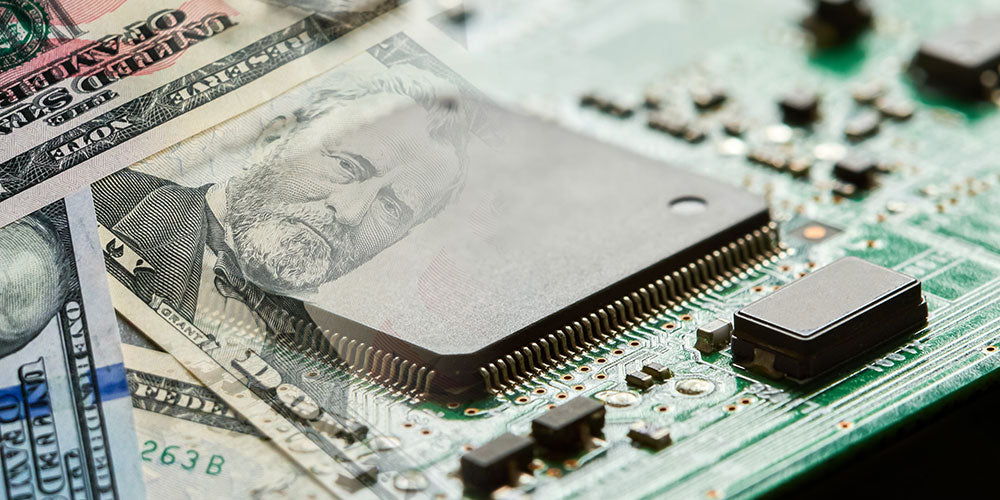Have you ever looked at surveillance cameras and wondered why there was such a wide range of prices and if you are getting more for your money or just paying too much? There are several points of discussion that we are going to look at with this subject but normally pricing breaks down into hardware components, features, and volume. There are other factors such as manufacturing costs, transportation & tariffs costs, brand recognition, and perceived value that can all affect the prices of equipment as well. I will touch on each of these and hopefully make it a bit easier to make buying decisions in the future when evaluating security equipment.
Before we begin, if price alone is the metric that you consider then the goal of the manufacturer targeting you would be to get every single thing on my list minimized as much as possible. For example, the consumer market is cut-throat because pricing is king and when you are chasing the bottom (referring to constantly trying to be the cheapest) you need to cut every corner possible. Cheaper hardware components, the use of surplus or obsolete chipsets, over-use of molded plastics, thinner circuit boards, cheaper labor costs, poor working conditions – you name it, if there is a cheaper option then that is what they would use.
Here is a quick example, you see brands like Lorex or Swann at Costco and assume that they are making the cameras, right? Those cameras are actually produced by two of the largest camera manufacturers in the world: Hikvision & Dahua. What about commercial camera companies such as LTS or ENS? It’s actually the same companies making those cameras too, even brands such as Honeywell and Bosch were using these same manufacturers that make products for them. So the question is if the same manufacturer are making the products why are the prices so varied and one of the reasons is that these companies use the consumer market to get rid of old chipsets or to sell older hardware that has become cheaper over time and use the cheapest material available to create these “entry-level” cameras whereas the mid and high tier products go to the commercial market where you will see the emergence of the newest technology, best hardware, and highest build quality.
Hardware Components:
This leads us into hardware components which will include the internal electronics, optics, and housing materials. One of the most important parts of your camera is the CMOS image sensor because this is responsible for the image clarity, crop, and light sensitivity. Most people look at the resolution of a camera without paying much attention to the image sensor being used but ignoring this can lead to being disappointed in the camera’s performance.

CMOS sensors comes in a variety of sizes but the most common in the CCTV market range between 1/4” to 1/1.8”. The larger the CMOS sensor, the better the ability to capture light quickly and the less image crop occurs. To keep pricing in check typically cameras will use a sensor around 1/3” (for example most Uniview cameras use 1/2.7” sensors) as this offers a good mix of performance without getting too expensive. Higher end cameras will usually have 1/2" CMOS or larger such as the 8MP Colorhunter camera using a 1/1.8” CMOS. Another feature you should look for is called BSI or backside illuminated. This change increases the light that can be captured and improves the low-light performance of a camera.
Next is the optics referring to the lens and this one can actually get really tough because only some aspects are published and can be compared. The main thing you should look at is the aperture maximum of the lens which will be listed like this f1.6 – the smaller the number after the “f” the wider the lens can open. The change in value can have a far larger impact that it appears such as a f1.0 lets in 4x more light than a f2.0 aperture. Lens quality will also have a huge impact on image clarity but this is something that doesn't show up on spec sheets.
Finally, the housing materials will affect the durability and vandal resistance of the camera. Usually cheaper cameras use a mixture of plastics as they are cheaper to produce and commercial camera tends to use either mostly metal or all metal construction which provides better longevity and heat dissipation.
Features:
Camera features can either be hardware or software based. For example, a built-in speaker enabling 2-way communication is a hardware-based feature whereas WDR (wide dynamic range) that allows the camera to see high contrast areas with better detail is a software-based feature. Some features require both hardware and software such as the newer smart Ai functions that use a dedicated IC chip to process the information provided from the software programming. The inclusion of features raises the price because the manufacturer needs to recoup their R&D costs to design the new feature, depending on the complexity the manufacturer may add those features to as many models as possible to limit the increase in cost per item.
Volume:
In the same way that adding a feature to a large portion of your products to keep the cost down, volume affects pricing due to the economies of scale - meaning the more of something you make the cheaper the manufacturing process becomes. Also selling high volumes of an item allows a manufacturer to sell them for less margin because of something referred to as inventory turns. Inventory turns is a measurement of speed based on the number of times that a product is sold in a fiscal calendar year – the higher the better.
Manufacturing Costs:
In manufacturing you have material, labor, maintenance, and equipment costs. The material cost can up or down depending on the scarcity of a materials – if they are plentiful then typically it will be cheaper but disruptions to the supply chain can adversely affect price like we saw with the 2020 COVID pandemic. Labor costs tend to be a businesses largest expense and if you make a product that is labor intensive, or if labor become more expensive, it can drive up costs quite a bit. The maintenance cost of keeping your production line active is another important factor because if the production line shuts down the manufacturer will start losing money until it is in operation again. Also, new tooling for new designs or the need to purchase new equipment is another significant factor with a high upfront cost to the manufacturer.
Transportation & Tariffs:
Transportation costs apply to every aspect of a product from getting the raw materials to a factory to getting the completed products to distributors. Globally, transportation costs have skyrocketed due to increased fuel costs, limited labor force, and demand far outpacing the transportation industries capacity. One example of this was containers ship via ocean freight, before the pandemic the average price for a full container to be shipped from China to the USA was around $7,000 but during the pandemic those prices were increased to over $20,000. During 2018, the USA imposed new tariffs on certain goods received from China that ranged from 10% to 25%. This applied to nearly every surveillance product and was a cost that was paid by the USA distributor directly to the Department of Customs and Border protections (CBP). All of these increased costs of doing business are factored into a products total cost basis and drive prices up for the end users.
Brand Recognition:
This is where you sometimes experience not getting more for your money. If 2 different private label brands are selling the same manufactured product but one of these brands is marketed to be more premium then you will typically see the premium brand charging more for that product because they expect their customers to be less price conscious. The other side of the coin with a truly premium brand is that they will specify higher quality products from manufacturers because the are upholding their brand’s reputation for being well-built and reliable.
Perceived Value:
Perception is a fickle thing but can have a profound impact on the price of an item. If a product is thought to be better by its customer-base then they would be willing to pay more for it and this is a marketing goal for many premium brands. Perceived value is different from most things on this list because it doesn’t need to be rooted in any tangible aspect of a product. Please note, I’m not saying that a product with a high perceived value hasn’t earned its reputation. What I am saying is that perceived value and actual value are not necessarily equal.
I have covered what I feel the biggest influences on the adage “you get what you pay for” starting from the beginning of the manufacturing phase to distributor’s marketing campaign. There are many influences on the cost of a product beyond simply distributor mark-up that should be considered and hopefully this list makes it more transparent why some products cost more than others. Factories making products using higher quality materials and manufacturing processes along with skilled labor will charge more than factories that produce cheap quality products but both of those companies can make an 8MP (4K resolution) IP camera (even if the products are not equivalent, they have the same product description). This is why it is important to be educated about what you are purchasing so you can maximize the money that you are investing in your security system.


